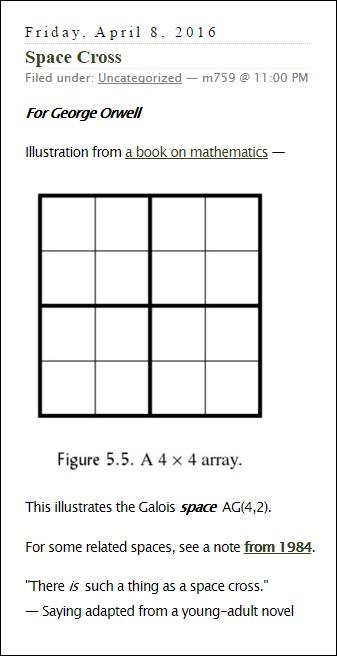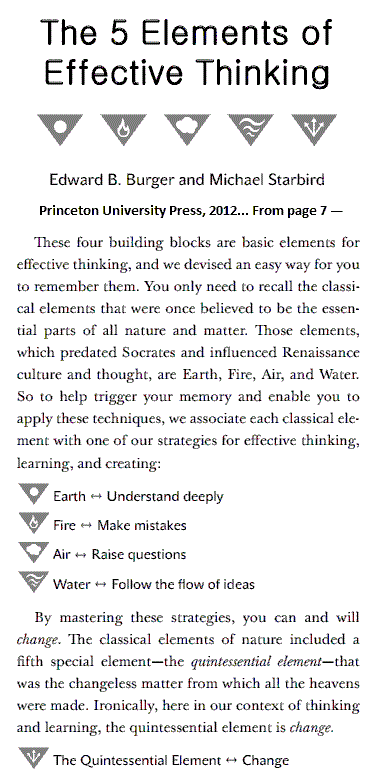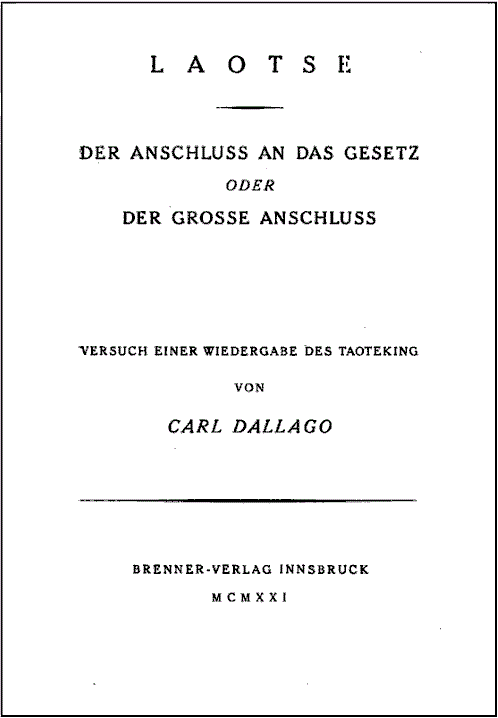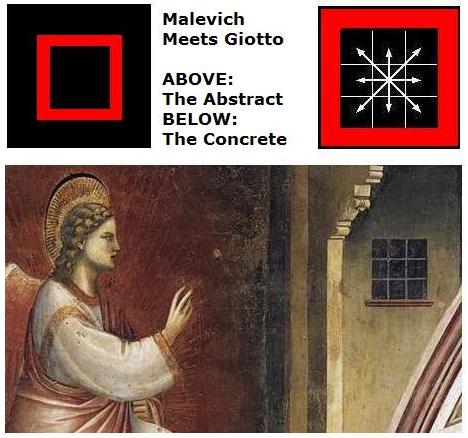Wednesday, August 2, 2023
Wednesday, July 28, 2021
From the Krell Lab
“… Which makes it a gilt-edged priority that one of us
gets into that Krell lab and takes that brain boost.”
— American adaptation of Shakespeare’s Tempest , 1956
|
“Propriation1 gathers the rift-design2 of the saying
— p. 415 of Heidegger‘s Basic Writings ,
“Das Ereignis versammelt den Aufriß der Sage — Heidegger, Weg zur Sprache 1. “Mirror-Play of the Fourfold” |
Wednesday, April 7, 2021
Timeless Capsules
Drilling down . . .


My own, more abstract, academic interests are indicated by
a post from this journal on January 20, 2020 —
Dyadic Harmonic Analysis: The Fourfold Square and Eightfold Cube.
Those poetically inclined may regard that post as an instance of the
“intersection of the timeless with time.”

Wednesday, January 27, 2021
Game of Royalties
For Holocaust Remembrance Day —

Little reportedly died at 79 on Jan. 7.
“Mr. Little submitted the manuscript for ‘Harry Potter and the Philosopher’s Stone’
to 12 publishers. He received 12 rejections in response, before selling it for £2,500,
or about $3,400 (the equivalent of about $5,800 today). It was a meager amount,
but his genius was in the details: He sold only the rights to publish it in Britain and
the Commonwealth, and he asked for high royalties.” — Clay Risen, New York Times
Leachman reportedly died at 94 today.
Dr. Frederick Frankenstein : And it was you… who left my grandfather’s
book out for me to find.
Frau Blücher : Yes.
Dr. Frederick Frankenstein : So that I would…
Frau Blücher : Yes.
Dr. Frederick Frankenstein : Then you and Victor were…
Frau Blücher : YES. YES. Say it. He vas my… BOYFRIEND!
In the spirit of Kinbote…
The real Frau Blücher was of course Hannah Arendt,
whose boyfriend was Martin Heidegger.
Cf. a Log24 post of April 10, 2017 —
| From “Heidegger for Passover”
“Propriation1 gathers the rift-design2 of the saying — p. 415 of Heidegger‘s Basic Writings , “Das Ereignis versammelt den Aufriß der Sage — Heidegger, Weg zur Sprache 1. “Mirror-Play of the Fourfold” |
Monday, January 20, 2020
Sunday, November 17, 2019
E-Elements Revisited
The German mathematician Wolf Barth in the above post is not the
same person as the Swiss artist Wolf Barth in today's previous post.
An untitled, undated, picture by the latter —
Compare and contrast with an "elements" picture of my own —
— and with . . .
“Lord Arglay had a suspicion that the Stone would be
purely logical. Yes, he thought, but what, in that sense,
were the rules of its pure logic?”
—Many Dimensions (1931), by Charles Williams
Tuesday, July 3, 2018
Propriation
The phrase "quantum space" in today's 10:45 AM post
was used earlier in a book title —
Amazon.com gives the Quantum Space publication date
for its Kindle edition as April 10, 2017.
I prefer my own remarks of April 10, 2017 —
|
From "Heidegger for Passover"
"Propriation1 gathers the rift-design2 of the saying
— p. 415 of Heidegger's Basic Writings ,
"Das Ereignis versammelt den Aufriß der Sage — Heidegger, Weg zur Sprache 1. "Mirror-Play of the Fourfold" |
Monday, December 18, 2017
Wheelwright and the Dance
The page preceding that of yesterday's post Wheelwright and the Wheel —

See also a Log24 search for
"Four Quartets" + "Four Elements".
A graphic approach to this concept:
"The Bounded Space" —
"The Fire, Air, Earth, and Water" —
Monday, April 10, 2017
Heidegger for Passover
From this journal on August 7, 2010 (footnotes added today) —
|
The title of this post, "Rift Designs," … is taken from Heidegger. From a recent New Yorker review of Absence of Mind by Marilynne Robinson— "Robinson is eloquent in her defense of the mind’s prerogatives, but her call for a renewed metaphysics might be better served by rereading Heidegger than by dusting off the Psalms." Following this advice, we find— "Propriation1 gathers the rift-design2 of the saying and unfolds it3 in such a way that it becomes the well-joined structure4 of a manifold showing." — p. 415 of Heidegger's Basic Writings , edited by David Farrell Krell, HarperCollins paperback, 1993 "Das Ereignis versammelt den Aufriß der Sage und entfaltet ihn zum Gefüge des vielfältigen Zeigens." — Heidegger, Weg zur Sprache 1. "Mirror-Play of the Fourfold" 2. "Christ descending into the abyss" 3. Barrancas of Cuernavaca 4. Combinatorics, Philosophy, Geometry |
Sunday, July 24, 2016
Point Omega …
In this post, "Omega" denotes a generic 4-element set.
For instance … Cullinane's
or Schmeikal's
 .
.
The mathematics appropriate for describing
group actions on such a set is not Schmeikal's
Clifford algebra, but rather Galois's finite fields.
Thursday, May 21, 2015
Gaze


The gaze of Juliette Binoche, star of the film Bleu ,
in a post of December 16, 2003, suggests the following…
From The Philosopher's Gaze, by David Michael Levin,
University of California Press, 1999 —
Now, the gathering of re-collection,
as a return to the opening ground,
a Rücknahme in den zu eröffnenden Grund ,
would be crucial to the transfiguration of the
figure-ground Gestalt: its release from the
disfigurements of enframing (Gestell ) and
its emergence and becoming as a gathering
of the fourfold. The opening, gathering, and
laying-down that would take place in and as
the ring of the Geviert is therefore to be
understood as entering into a figure-ground
formation, a Gestalt , that our looking and
seeing would have opened up, gathered,
and laid down by virtue of their being (or say
by virtue of their character as) a hermeneutical
re-collection of being, gathering the presencing
of the lighting, the boundless giving-to-be-hold
of the field, into the pain and the thankfulness
of memory.
A hermeneutical re-collection —
Log24 posts tagged May 19 Gestalt.
Friday, May 8, 2015
Spielraum
Review:
Illustrating the Spiegel-Spiel des Gevierts
|
"At the point of convergence
by Octavio Paz, translated by |
Friday December 5, 2008
|
Saturday, April 11, 2015
Friday, October 17, 2014
Raiders of the Inarticulate
On Walter Isaacson’s The Innovators :
“Yet as the book’s five hundred–plus pages unwind, Isaacson interrupts himself to present small bromides about what it means to innovate and what we might learn from these innovators, our presumed betters. “Innovation requires articulation,” he tells us, after explaining how the main strength of Grace Hopper, a trailblazing computer scientist for the US Navy, was her ability to speak in the languages of mathematicians, engineers, programmers, and soldiers alike. ‘One useful leadership talent is knowing when to push ahead against doubters and when to heed them,’ he offers later.
The book is peppered with these kinds of passages, which often intrude on the narrative, depriving us of moments of real emotional power.”
— Jacob Silverman in Bookforum , Sept/Oct/Nov 2014
From Isaacson’s book:
Related material:
In memory of T. S. Eliot…
… and in memory of Stanley Chase, producer of Colossus: The Forbin Project
and of Threepenny Opera :
Ninefold square from Colossus
(“There is another system”) —
Fourfold square introducing Brecht
in Dreigroschen Trifft Vierfarben —
Sunday, July 27, 2014
George Johnson’s Theory of Everything
George Johnson, a science writer, in The New York Times
on July 21, 2014:
“New particles may yet be discovered, and even new laws.
But it is almost taken for granted that everything
from physics to biology, including the mind,
ultimately comes down to four fundamental concepts:
matter and energy interacting in an arena of space and time.”
Related material:
Ite, missa est.
Saturday, July 12, 2014
Mars Package

“For me it is a sign that we have fundamentally different
conceptions of the work of the intelligence services.”
— Germany’s Chancellor Angela Merkel in
theguardian.com, Saturday, 12 July 2014, 14.32 EDT
Another sort of service, thanks to Dan Brown and Tom Hanks:
Friday, July 11, 2014 |
Wednesday, March 13, 2013
Intersection
… to apprehend
The point of intersection of the timeless
With time, is an occupation for the saint
— Four Quartets

Intersection sign,
courtesy of Donald Knuth
Related material:
The previous post and Fourfold in this journal.
Saturday, August 7, 2010
Rift Designs
From the current index to obituaries at Telegraph.co.uk—

Teufel is also featured in today's New York Times—
"Mr. Teufel became a semicelebrity, helped in no small part by his last name, which means 'devil' in German."
From Group Analysis , June 1993, vol. 26 no. 2, 203-212—
by Ronald Sandison, Ledbury, Herefordshire HR8 2EY, UK
In my contribution to the Group Analysis Special Section: "Aspects of Religion in Group Analysis" (Sandison, 1993) I hinted that any consideration of a spiritual dimension to the group involves us in a discussion on whether we are dealing with good or evil spirits. But if we say that God is in the group, why is not the Devil there also? Can good and evil coexist in the same group matrix? Is the recognition of evil "nothing but" the ability to distinguish between good and bad? If not, then what is evil? Is it no more than the absence of good?
These and other questions were worked on at a joint Institute of Group Analysis and Group-Analytic Society (London) Workshop entitled "The Problem of Good and Evil." We considered the likelihood that good and evil coexist in all of us, as well as in the whole of the natural world, not only on earth, but in the cosmos and in God himself What we actually do with good and evil is to split them apart, thereby shelving the problem but at the same time creating irreconcilable opposites. This article examines this splitting and how we can work with it psychoanalytically.
This suggests a biblical remark—
"Now there was a day… when the sons of God
came to present themselves before the Lord,
and Satan came also among them."
— Job 1:6, quoted by Chesterton in The Man Who Was Thursday
Sandison died on June 18. See the Thursday, August 5, Log24 post "The Matrix."
Teufel died on July 6. See the Log24 posts for that day.
The title of this post, "rift designs," refers to a recurring theme in the July 6 posts. It is taken from Heidegger.
From a recent New Yorker review of Absence of Mind by Marilynne Robinson—
"Robinson is eloquent in her defense of the mind’s prerogatives, but her call for a renewed metaphysics might be better served by rereading Heidegger than by dusting off the Psalms."
Following this advice, we find—
"Propriation gathers the rift-design of the saying and unfolds it in such a way that it becomes the well-joined structure of a manifold showing."
— p. 415 of Heidegger's Basic Writings , edited by David Farrell Krell, HarperCollins paperback, 1993
"Das Ereignis versammelt den Aufriß der Sage und entfaltet ihn zum Gefüge des vielfältigen Zeigens."
— Heidegger, Weg zur Sprache
Sunday, July 11, 2010
Language Lab
From a search in this journal for "Krell"—
Dialogue from an American adaptation of Shakespeare's Tempest—
“… Which makes it a gilt-edged priority that one of us
gets into that Krell lab and takes that brain boost.”
– Taken from a video, Forbidden Planet Monster Attack

From yesterday's A Manifold Showing—
"Propriation gathers the rift-design of the saying and unfolds it
in such a way that it becomes the well-joined structure of a manifold showing."
(p. 415 of Heidegger's Basic Writings, edited by David Farrell Krell,
HarperCollins paperback, 1993)
German versions found on the Web—
„Das Ereignis versammelt den Aufriß der Sage und entfaltet ihn zum Gefüge des vielfältigen Zeigens.“ 323
323 Heidegger, Weg zur Sprache, S. 259.
"Das Regende im Zeigen der Sage ist das Eignen. Es erbringt das An- und Abwesen in sein jeweilig Eigenes, aus dem dieses sich an ihm selbst zeigt und nach seiner Art verweilt. Das erbringende Eignen, das die Sage als die Zeige in ihrem Zeigen regt, heiße das Ereignen. Es er-gibt das Freie der Lichtung, in die Anwesendes anwähren, aus der Abwesendes entgehen und im Entzug sein Währen behalten kann. Was das Ereignen durch die Sage ergibt, ist nie Wirkung einer Ursache, nicht die Folge eines Grundes. Das erbringende Eignen, das Ereignen, ist gewährender als jedes Wirken, Machen und Gründen. Das Ereignende ist das Ereignis selbst – und nichts außerdem. Das Ereignis, im Zeigen der Sage erblickt, läßt sich weder als ein Vorkommnis noch als ein Geschehen vorstellen, sondern nur im Zeigen der Sage als das Gewährende erfahren. Es gibt nichts anderes, worauf das Ereignis noch zurückführt, woraus es gar erklärt werden könnte. Das Ereignen ist kein Ergebnis (Resultat) aus anderem, aber die Er-gebnis, deren reichendes Geben erst dergleichen wie ein `Es gibt' gewährt, dessen auch noch `das Sein' bedarf, um als Anwesen in sein Eigenes zu gelangen. Das Ereignis versammelt den Aufriß der Sage und entfaltet ihn zum Gefüge des Vielfältigen Zeigens. Das Ereignis ist das Unscheinbarste des Unscheinbaren, das Einfachste des Einfachen, das Nächste des Nahen und das Fernste des Fernen, darin wir Sterbliche uns zeitlebens aufhalten." 8
8 M. Heidegger: Unterwegs zur Sprache. S. 258 f.
From Google Translate:
"The event brings together the outline of the legend and unfolds it to the structure of the manifold showing."
Saturday, July 10, 2010
A Manifold Showing
"Heidegger suggests that we experience the saying of language as a shining forth:
'It lets what is coming to presence shine forth, lets what is withdrawing into absence vanish. The saying is by no means the supplemental linguistic expression of what shines forth; rather, all shining and fading depend on the saying that shows.' (pp. 413-414).
But what is the basis and origin of this possibility of saying? The happening of saying in the clearing, its allowing things to shine forth, can also be called an 'owning.' Owning is the event of a thing’s coming into its own, of its showing itself as itself. Heidegger also calls it 'propriating,' 'en-owning,' or Ereignis:
'Propriation gathers the rift-design of the saying and unfolds it in such a way that it becomes the well-joined structure of a manifold showing. (p. 415)'"
— "Heidegger: On the Way to Language," by Paul Livingston
Page references are apparently to Heidegger's Basic Writings, edited by David Farrell Krell, HarperCollins paperback, 1993.
See also Shining Forth.
Tuesday, January 26, 2010
Symbology
From this journal:
Friday December 5, 2008Mirror-Play of
the Fourfold For an excellent commentary View selected pages Play and the Aesthetic Dimension (Mihai I. Spariosu, Related material: – and Theme and Variations. |
Transition to the
Garden of Forking Paths–
(See For Baron Samedi)–
The Found Symbol

and Dissemination, by Jacques Derrida,
translated by Barbara Johnson,
London, Athlone Press, 1981–
Pages 354-355
On the mirror-play of the fourfold
Pages 356-357
Shaking up a whole culture
Pages 358-359
Cornerstone and crossroads
Pages 360-361
A deep impression embedded in stone
Pages 362-363
A certain Y, a certain V
Pages 364-365
The world is Zeus's play
Page 366
It was necessary to begin again
Sunday, September 27, 2009
Sunday September 27, 2009
Discursive Treatment
Unitarian Universalist Origins: Our Historic Faith—
“In sixteenth-century Transylvania, Unitarian congregations were established for the first time in history.”
Gravity’s Rainbow–
“For every kind of vampire, there is a kind of cross.”
Unitarian minister Richard Trudeau—
“… I called the belief that
(1) Diamonds– informative, certain truths about the world– exist
the ‘Diamond Theory’ of truth. I said that for 2200 years the strongest evidence for the Diamond Theory was the widespread perception that
(2) The theorems of Euclidean geometry are diamonds….
As the news about non-Euclidean geometry spread– first among mathematicians, then among scientists and philosophers– the Diamond Theory began a long decline that continues today.
Factors outside mathematics have contributed to this decline. Euclidean geometry had never been the Diamond Theory’s only ally. In the eighteenth century other fields had seemed to possess diamonds, too; when many of these turned out to be man-made, the Diamond Theory was undercut. And unlike earlier periods in history, when intellectual shocks came only occasionally, received truths have, since the eighteenth century, been found wanting at a dizzying rate, creating an impression that perhaps no knowledge is stable.
Other factors notwithstanding, non-Euclidean geometry remains, I think, for those who have heard of it, the single most powerful argument against the Diamond Theory*– first, because it overthrows what had always been the strongest argument in favor of the Diamond Theory, the objective truth of Euclidean geometry; and second, because it does so not by showing Euclidean geometry to be false, but by showing it to be merely uncertain.” —The Non-Euclidean Revolution, p. 255
H. S. M. Coxeter, 1987, introduction to Trudeau’s book—
“There is a pleasantly discursive treatment of Pontius Pilate’s unanswered question ‘What is truth?’.”
As noted here on Oct. 8, 2008 (A Yom Kippur Meditation), Coxeter was aware in 1987 of a more technical use of the phrase “diamond theory” that is closely related to…
of cross:

Saturday, December 6, 2008
Saturday December 6, 2008
| Abstraction and Faith On Kirk Varnedoe’s National Gallery lectures in 2003 (Philip Kennicott, Washington Post, Sunday, May 18, 2003): “Varnedoe’s lectures were ultimately about faith, about his faith in the power of abstraction, and abstraction as a kind of anti-religious faith in itself.”
|
et lux in tenebris lucet
et tenebrae eam non conprehenderunt
… the mirroring …
is to be conceived of as
a shining forth, a play of mirror flashes,
as it were…. The four “mirrors”
emerge into presence as light
at the same time that they converge….
The above image:
Axes of Reflection
and Annunciation,
the latter being a detail
of a fresco by Giotto
on the cover of
The Pearly Gates of Cyberspace.
Happy Feast of St. Nicholas.
Friday, December 5, 2008
Friday December 5, 2008
the Fourfold
For an excellent commentary
on this concept of Heidegger,
View selected pages
from the book
Play and the Aesthetic Dimension
in Modern Philosophical and
Scientific Discourse
(Mihai I. Spariosu,
Cornell U. Press, 1989)
Related material:
the logo for a
web page—
— and Theme and Variations.
Wednesday, June 25, 2008
Wednesday June 25, 2008
the Elements
John Baez, Week 266
(June 20, 2008):
“The Renaissance thinkers liked to
organize the four elements using
a chain of analogies running
from light to heavy:
fire : air :: air : water :: water : earth
They also organized them
in a diamond, like this:”

This figure of Baez
is related to a saying
attributed to Heraclitus:

For related thoughts by Jung,
see Aion, which contains the
following diagram:

“The formula reproduces exactly the essential features of the symbolic process of transformation. It shows the rotation of the mandala, the antithetical play of complementary (or compensatory) processes, then the apocatastasis, i.e., the restoration of an original state of wholeness, which the alchemists expressed through the symbol of the uroboros, and finally the formula repeats the ancient alchemical tetrameria, which is implicit in the fourfold structure of unity.”
— Carl Gustav Jung
That the words Maximus of Tyre (second century A.D.) attributed to Heraclitus imply a cycle of the elements (analogous to the rotation in Jung’s diagram) is not a new concept. For further details, see “The Rotation of the Elements,” a 1995 webpage by one “John Opsopaus.”
Related material:
Log24 entries of June 9, 2008, and
“Quintessence: A Glass Bead Game,”
by Charles Cameron.
Thursday, December 8, 2005
Thursday December 8, 2005
— Poem title, Gerard Manley Hopkins
From Jung’s Map of the Soul, by Murray Stein:
“… Jung thinks of the self as undergoing continual transformation during the course of a lifetime…. At the end of his late work Aion, Jung presents a diagram to illustrate the dynamic movements of the self….”

“The formula presents a symbol of the self, for the self is not just a stable quantity or constant form, but is also a dynamic process. In the same way, the ancients saw the imago Dei in man not as a mere imprint, as a sort of lifeless, stereotyped impression, but as an active force…. The four transformations represent a process of restoration or rejuvenation taking place, as it were, inside the self….”
“The formula reproduces exactly the essential features of the symbolic process of transformation. It shows the rotation of the mandala, the antithetical play of complementary (or compensatory) processes, then the apocatastasis, i.e., the restoration of an original state of wholeness, which the alchemists expressed through the symbol of the uroboros, and finally the formula repeats the ancient alchemical tetrameria, which is implicit in the fourfold structure of unity.
What the formula can only hint at, however, is the higher plane that is reached through the process of transformation and integration. The ‘sublimation’ or progress or qualitative change consists in an unfolding of totality into four parts four times, which means nothing less than its becoming conscious. When psychic contents are split up into four aspects, it means that they have been subjected to discrimination by the four orienting functions of consciousness. Only the production of these four aspects makes a total description possible. The process depicted by our formula changes the originally unconscious totality into a conscious one.”
— Jung, Collected Works,
Vol. 9, Part 2, Aion: Researches into the Phenomenology of the Self (1951)
Related material:
“Although ‘wholeness’ seems at first sight to be nothing but an abstract idea (like anima and animus), it is nevertheless empirical in so far as it is anticipated by the psyche in the form of spontaneous or autonomous symbols. These are the quaternity or mandala symbols, which occur not only in the dreams of modern people who have never heard of them, but are widely disseminated in the historical recods of many peoples and many epochs. Their significance as symbols of unity and totality is amply confirmed by history as well as by empirical psychology. What at first looks like an abstract idea stands in reality for something that exists and can be experienced, that demonstrates its a priori presence spontaneously. Wholeness is thus an objective factor that confronts the subject independently of him… Unity and totality stand at the highest point on the scale of objective values because their symbols can no longer be distinguished from the imago Dei. Hence all statements about the God-image apply also to the empirical symbols of totality.”
— Jung, Aion, as quoted in
Carl Jung and Thomas Merton






















